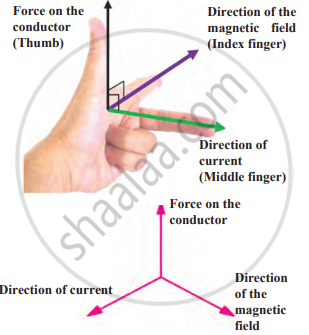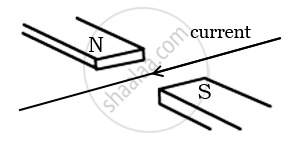Advertisements
Advertisements
Question
Name the following diagram and explain the concept behind it.

Solution
Fleming's left hand rule
It represents Fleming's left-hand rule used for finding the direction of magnetic force when a current-carrying conductor is placed in a magnetic field.

According to this rule, the left-hand thumb, index finger, and middle finger are stretched so as to be perpendicular to each other. If the index finger is in the direction of the magnetic field and the middle finger points in the direction of the current, then the direction of the thumb is the direction of the force on the conductor.
APPEARS IN
RELATED QUESTIONS
A positively-charged particle (alpha-particle) projected towards west is deflected towards north by a magnetic field. The direction of magnetic field is ______.
What concealed do you get from the observation that a current-carrying wire deflects a compass needle placed near it?
Describe how you will locate a current-carrying wire concealed in a wall.
Name and state the rule to determine the direction of magnetic field around a straight current-carrying conductor.
What are the various ways in which the strength of magnetic field produced by a current-carrying circular coil can be increased?
State and explain the Clock face rule for determining the polarities of a circular wire carrying current.
What is a solenoid? Draw a sketch to show the magnetic field pattern produced by a current-carrying solenoid.
Name the type of magnet with which the magnetic field pattern of a current-carrying solenoid resembles
The diagram given below represents magnetic field caused by a current-carrying conductor which is:

(a) a long straight wire
(b) a circular coil
(c) a solenoid
(d) a short straight wire
A soft iron bar is inserted inside a current-carrying solenoid. The magnetic field inside the solenoid:
(a) will decrease
(b) will increase
(c) will become zero
(d) will remain the same
The magnetic field lines in the middle of the current-carrying solenoid are?
(a) circles
(b) spirals
(c) parallel to the axis of the tube
(d) perpendicular to the axis of the tube
A current-carrying straight wire is held in exactly vertical position. If the current passes through this wire in the vertically upward direction, what is the direction of magnetic field produced by it? Name the rule used to find the direction of magnetic field.
The magnetic field associated with a current-carrying straight conductor is in anticlockwise direction. If the conductor was held along the east-west direction, what will be the direction of current through it? Name and state the rule applied to determine the direction of current?
A current-carrying conductor is held in exactly vertical direction. In order to produce a clockwise magnetic field around the conductor, the current should passed in the conductor:
(a) from top towards bottom
(b) from left towards right
(c) from bottom towards top
(d) from right towards left
What happens when a current-carrying conductor is placed in a magnetic field?
In a statement of Fleming's left-hand rule, what do the following represent?
(a) direction of centre finger.
(b) direction of forefinger.
(c) direction of thumb.
A current-carrying conductor is placed perpendicularly in a magnetic field. Name the rule which can be used to find the direction of force acting on the conductor.
The force exerted on a current-carrying wire placed in a magnetic field is zero when the angle between the wire and the direction of magnetic field is:
45°
60°
90°
180°
A current flows in a wire running between the S and N poles of a magnet lying horizontally as shown in Figure below:
The force on the wire due to the magnet is directed:

fron N to S
from S to N
vertically downwards
vertically upwards
In the simple electric motor of figure given below, the coil rotates anticlockwise as seen by the eye from the position X when current flows in the coil

Is the current flowing clockwise or anticlockwise around the coil when viewed from above?
force experienced by a current-carrying straight conductor placed in a magnetic field which is perpendicular to it.
State condition when magnitude of force on a current carrying conductor placed in a magnetic field is maximum?
State under what conditions force acting on a current carrying conductor which is freely suspended in a magnetic field can be maximum.
Write Fleming’s left hand rule.
A current flows in a wire running between the S and N poles of a magnet lying horizontally as shown in the figure below:

The force on the wire due to the magnet is directed ____________.
Which of the following factors affect the strength of force experience by current-carrying conduct in a uniform magnetic field?
A magnetic field directed in north direction acts on an electron moving in east direction. The magnetic force on the electron will act ____________.
The direction of force on a current carrying conductor in a magnetic field is given by ____________.
For a current in a long straight solenoid N- and S-poles are created at the two ends. Among the following statements, the incorrect statement is
Describe the activity that shows that a current-carrying conductor experiences a force perpendicular to its length and the external magnetic field. How does Fleming’s left-hand rule help us to find the direction of the force acting on the current carrying conductor?
Observe the given figure of Fleming's Left Hand Rule and write the labels of 'A' and 'B':

Which of the following pattern correctly describes the magnetic field around a long straight wire carrying current?
